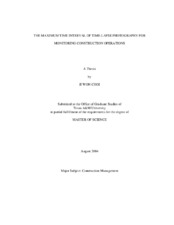| dc.description.abstract | Many construction companies today utilize webcams on their jobsites to monitor and record construction operations. Jobsite monitoring is often limited to outdoor construction operations due to lack of mobility of wired webcams. A wireless webcam may help monitor indoor construction operations with enhanced mobility. The transfer time of sending a photograph from the wireless webcam, however, is slower than that of a wired webcam. It is expected that professionals may have to analyze indoor construction operations with longer interval time-lapse photographs if they want to use a wireless webcam. This research aimed to determine the maximum time interval for time-lapse photos that enables professionals to interpret construction operations and productivity.
In order to accomplish the research goal, brickwork of five different construction sites was videotaped. Various interval time-lapse photographs were generated from each video. Worker?s activity in these photographs was examined and graded. The grades in one-second interval photographs were compared with the grades of the same in longer time interval photographs. Error rates in observing longer time-lapse photographs were then obtained and analyzed to find the maximum time interval of time-lapse photography for monitoring construction operations.
Research has discovered that the observation error rate increased rapidly until the 60-second interval and its increasing ratio remained constant. This finding can be used to predict a reasonable amount of error rate when observing time-lapse photographs less than 60-second interval. The observation error rate with longer than 60-second interval did not show a constant trend. Thus, the 60-second interval could be considered as the maximum time interval for professionals to interpret construction operations and productivity. | en |


